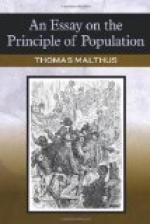NEUMARK OF BRANDENBURGH
Proportion Proportion Annual Average Births Burials Marriages of Births to of Births to Marriages Burials 5 yrs to 1701 5,433 3,483 1,436 37 to 10 155 to 100 5 yrs to 1726 7,012 4,254 1,713 40 to 10 164 to 100 5 yrs to 1756 7,978 5,567 1,891 42 to 10 143 to 100
“Epidemics prevailed for six years, from 1736, to 1741, which checked the increase.”
DUKEDOM OF MAGDEBURGH
Proportion Proportion Annual Average Births Burials Marriages of Births to of Births to Marriages Burials 5 yrs to 1702 6,431 4,103 1,681 38 to 10 156 to 100 5 yrs to 1717 7,590 5,335 2,076 36 to 10 142 to 100 5 yrs to 1756 8,850 8,069 2,193 40 to 10 109 to 100
“The years 1738, 1740, 1750, and 1751, were particularly sickly.”
For further information on this subject, I refer the reader to Mr Suessmilch’s tables. The extracts that I have made are sufficient to shew the periodical, though irregular, returns of sickly seasons, and it seems highly probable that a scantiness of room and food was one of the principal causes that occasioned them.
It appears from the tables that these countries were increasing rather fast for old states, notwithstanding the occasional seasons that prevailed. Cultivation must have been improving, and marriages, consequently, encouraged. For the checks to population appear to have been rather of the positive, than of the preventive kind. When from a prospect of increasing plenty in any country, the weight that represses population is in some degree removed, it is highly probable that the motion will be continued beyond the operation of the cause that first impelled it. Or, to be more particular, when the increasing produce of a country, and the increasing demand for labour, so far ameliorate the condition of the labourer as greatly to encourage marriage, it is probable that the custom of early marriages will continue till the population of the country has gone beyond the increased produce, and sickly seasons appear to be the natural and necessary consequence. I should expect, therefore, that those countries where subsistence was increasing sufficiency at times to encourage population but not to answer all its demands, would be more subject to periodical epidemics than those where the population could more completely accommodate itself to the average produce.




